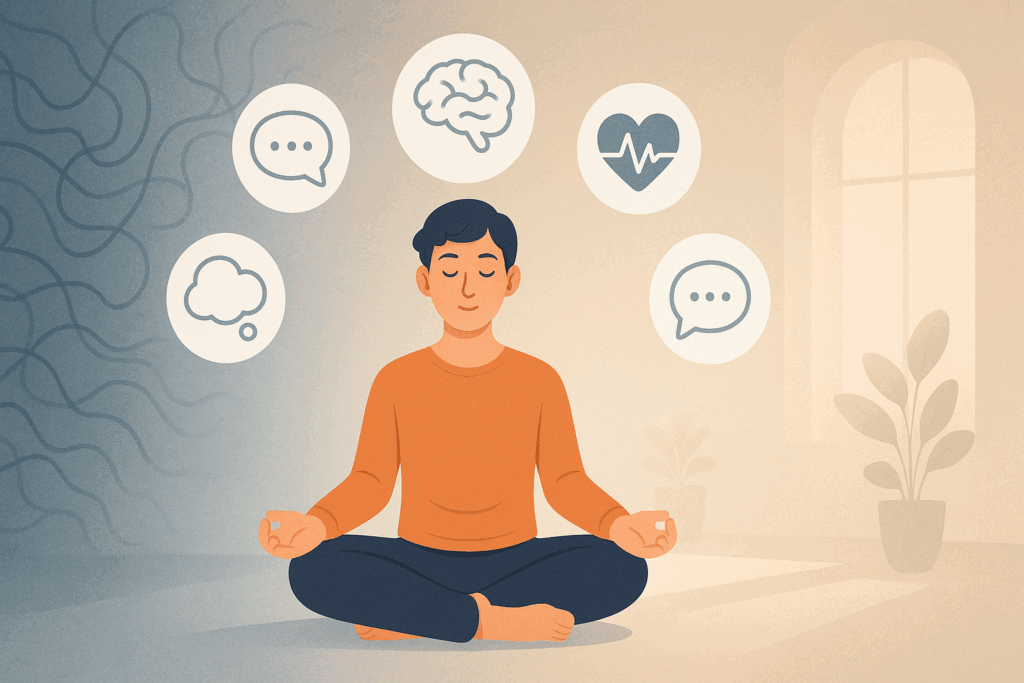Introduction: Mental Strength as a Foundation for Resilience
In moments of high stakes and uncertainty, your ability to stay calm, focused, and composed determines not just the outcome, but also your growth as a resilient individual. Whether you’re an athlete performing under stadium lights, a student facing the intensity of final exams, or a professional navigating boardroom challenges, mental resilience is the differentiating factor between those who endure and those who excel. The human mind, complex and adaptive, holds untapped potential when trained deliberately. This potential includes cultivating attitudes and behaviors that make you strong under pressure. Mental fortitude is not an innate trait given only to a few; rather, it’s a skill set—one that can be practiced, strengthened, and applied in the face of adversity.
You may also like: The Essential Mental Shift: How to Train Your Mind to Be Stronger for Peak Performance
Mental toughness, often associated with the term “grit,” is grounded in psychology, neuroscience, and performance science. It extends beyond willpower or temporary motivation. It involves a strategic alignment of cognition, emotion regulation, and behavioral discipline. For those asking, “how do I become stronger” or “how do I get stronger” in mentally demanding situations, the answer lies not in muscle but in mindset. This article delves deep into the psychological mechanisms, evidence-backed techniques, and practical strategies that cultivate mental strength. It aims to empower readers with tools that not only help them endure challenges but thrive under them.

Reframing Stress: From Threat to Challenge
One of the most transformative mental shifts in high-pressure situations is the reappraisal of stress. The human brain, particularly the amygdala, interprets stress as a threat by default. This can trigger the fight-or-flight response, releasing cortisol and adrenaline, narrowing our focus, and preparing us to escape rather than engage. However, psychological studies, notably by researchers like Dr. Kelly McGonigal, suggest that when individuals reinterpret stress as a sign of readiness, their performance and well-being improve.
This reappraisal is not mere positive thinking. It is a deliberate cognitive shift in perspective, transforming the perception of pressure from something harmful to something invigorating. For example, elite performers in sports and military training are taught to view adrenaline not as a panic signal but as a source of heightened energy. By reframing stress, they unlock physiological and psychological resources that make them more agile, alert, and focused.
For everyday professionals, this can mean approaching a tense meeting not with dread but as a platform to showcase preparedness and adaptability. Cognitive-behavioral strategies such as self-talk, visualization, and labeling emotions help implement this reframe. Telling yourself, “I am excited,” rather than “I am anxious,” activates different neural pathways, subtly shifting emotional response patterns. These cognitive reframes are the gateway to greater composure and adaptability, key components that make you strong in times of uncertainty.

Cultivating Self-Awareness to Sustain Composure
Self-awareness lies at the heart of all meaningful mental training. Without the ability to observe your thoughts, emotions, and physiological signals, it becomes nearly impossible to regulate them. In high-pressure environments, those who remain calm often do so not because they feel no stress, but because they recognize their internal cues early and act preemptively.
The development of self-awareness begins with mindful attention. Techniques rooted in mindfulness meditation have been shown in neuroscience research to increase activity in the prefrontal cortex, which governs executive functions like planning, judgment, and impulse control. Regular mindfulness practice fosters a non-reactive awareness of one’s internal state, allowing for thoughtful response rather than impulsive reaction.
Another key practice is journaling. Reflective writing helps externalize thoughts and emotions, providing a clearer picture of internal narratives that may be undermining confidence. This is particularly helpful for those exploring how to get stronger in managing performance anxiety. By identifying patterns of negative self-talk or cognitive distortions—like catastrophizing or all-or-nothing thinking—individuals can begin restructuring these narratives in more empowering ways.
The application of biofeedback is also gaining traction. Devices that measure heart rate variability (HRV) offer real-time data about the body’s stress response, allowing users to track their physiological reactions and adjust breathing or posture accordingly. This convergence of technology and self-awareness reinforces the idea that strong strength is not only mental but also embodied, highlighting the interplay between mind and body.

Goal Setting as a Framework for Mental Endurance
One of the most practical techniques to develop mental resilience is effective goal setting. Clear, structured goals anchor attention and motivation, providing direction when external circumstances feel overwhelming. However, not all goals are created equal. The SMART framework (Specific, Measurable, Achievable, Relevant, Time-bound) is often cited for its clarity, but deeper mental strength comes from integrating process goals alongside outcome goals.
Process goals emphasize controllable actions rather than final results. For instance, instead of saying, “I will win this competition,” a process goal would be, “I will follow my training regimen precisely every day this week.” This subtle shift reduces performance anxiety and enhances a sense of control, both of which make you strong against the destabilizing effects of uncertainty.
Longitudinal studies in sports psychology reveal that athletes who internalize goals aligned with intrinsic motivation are more resilient under pressure. They are driven not by fear of failure but by a commitment to personal growth and mastery. This psychological orientation can be translated to academic, corporate, or creative domains by framing goals around learning, experimentation, and skill refinement.
Moreover, tracking progress through visual methods such as habit trackers or performance dashboards reinforces consistency. The act of recording and reflecting on small wins nurtures a growth mindset, which research by Dr. Carol Dweck shows is a powerful determinant of perseverance. In this sense, goal setting is not just an administrative task but a mental technique that scaffolds sustained effort and makes you strong even when setbacks arise.

Harnessing Visualization and Mental Rehearsal
The power of visualization is well-documented across disciplines ranging from elite sports to surgical training. Mental imagery activates many of the same neural circuits as actual physical practice, enhancing motor learning, confidence, and emotional control. Athletes like Michael Phelps and Serena Williams have credited visualization as a critical component of their performance routines.
The effectiveness of visualization lies in its specificity and emotional engagement. When visualizing success under pressure, it is important to incorporate not just visual details, but also sensory cues, internal dialogue, and emotional states. For example, a musician preparing for a high-stakes audition might mentally rehearse the performance, imagining the stage lights, the sound of the instrument, the feeling of confidence, and even the expected nervousness. This comprehensive simulation prepares the mind for reality, reducing shock and disorientation when the moment arrives.
Mental rehearsal is particularly helpful for those wondering, “how do I become stronger” in managing performance anxiety or public speaking. By repeatedly exposing oneself to imagined scenarios of stress, the brain adapts and becomes less reactive over time. This technique can be applied to job interviews, exams, conflict resolution, and emergency response. The consistency of visualization practices builds a mental script that guides behavior automatically, even under duress.
Practitioners are encouraged to pair visualization with deep breathing and progressive muscle relaxation to condition the body into associating high-pressure thoughts with calm responses. This alignment between imagery and physiological regulation creates an embodied resilience that reflects the essence of strong strength.

The Role of Cognitive Flexibility in Adaptive Thinking
In a fast-changing world, rigidity of thought becomes a liability. Cognitive flexibility—the ability to switch perspectives, adapt strategies, and reinterpret meaning—is a cornerstone of psychological resilience. This skill is especially valuable in unpredictable or novel environments, where pre-set routines may no longer apply.
Psychological research suggests that individuals with high cognitive flexibility are better at problem-solving, exhibit lower levels of stress, and demonstrate faster recovery from emotional setbacks. In practical terms, this means that instead of being paralyzed by failure, they quickly reframe it as feedback. Instead of clinging to a single strategy, they explore alternatives with curiosity.
One way to develop cognitive flexibility is through the practice of divergent thinking. This involves generating multiple solutions to a problem rather than seeking a single correct answer. Journaling, brainstorming, and mind mapping are useful techniques to train this ability. Reading widely across disciplines also enhances neural plasticity by exposing the brain to varied patterns and ideas.
Furthermore, cultivating humility—the recognition that one’s current knowledge may be incomplete—opens the door to learning and adaptation. High performers who ask, “how do I get stronger in unfamiliar territory?” benefit greatly from this openness. They seek mentorship, embrace feedback, and experiment with new approaches.
Cognitive flexibility also intersects with emotional intelligence. Those who can shift from self-criticism to self-compassion, or from blame to curiosity, exhibit stronger interpersonal resilience. In high-pressure teams, this trait fosters collaboration, innovation, and morale, all of which make you strong not just individually but collectively.
Self-Talk: The Dialogue That Shapes Performance
The internal conversation you maintain with yourself, often called self-talk, is one of the most potent influencers of mental performance. This silent dialogue can either sabotage or elevate your potential, especially under pressure. Studies in sports psychology and cognitive behavioral therapy consistently show that the quality of self-talk correlates with performance outcomes, emotional regulation, and resilience.
There are three primary types of self-talk: instructional, motivational, and evaluative. Instructional self-talk involves task-specific cues like “stay balanced” or “focus on your breath.” Motivational self-talk uses phrases like “you’ve got this” to boost confidence and energy. Evaluative self-talk reflects on past actions and can be either constructive or destructive. Individuals who habitually criticize themselves after mistakes tend to internalize failure and avoid risk.
To build a positive self-talk routine, it is essential to first become aware of your dominant inner narratives. Are they empowering or undermining? Do they reflect self-belief or self-doubt? This awareness, often cultivated through journaling or mindfulness, enables intentional intervention. Replacing critical thoughts with affirming ones is not about delusion but about balance. The goal is to develop an inner coach rather than an inner critic.
Language matters deeply in this process. Using the second person (“You can do this”) rather than the first person (“I can do this”) has been shown to create psychological distance and enhance performance. This technique mirrors how one might coach a friend, fostering encouragement without emotional entanglement.
Incorporating self-talk rituals into daily routines can create a psychological buffer against high-pressure situations. For instance, repeating a personal mantra before presentations, rehearsing affirmations during commutes, or writing encouraging notes in planners can normalize self-support. These habits, when practiced consistently, make you strong by internalizing resilience as a default mental stance.
Frequently Asked Questions: Proven Mental Techniques That Make You Strong Under Pressure
How Does Neuroplasticity Contribute to Mental Strength Development?
Neuroplasticity is the brain’s ability to reorganize itself by forming new neural connections throughout life. This adaptability is critical for building mental strength because it means we are not fixed in our emotional or behavioral responses. For those asking, “how do I become stronger mentally?” the answer lies in leveraging neuroplasticity through deliberate practice. Activities like meditation, learning new skills, or engaging in cognitive-behavioral exercises encourage the brain to create more resilient pathways. Over time, these new connections reinforce patterns that make you strong in the face of psychological stressors, fostering adaptability and self-control.
Can Physical Exercise Actually Improve Mental Fortitude?
Yes, physical exercise plays a surprisingly significant role in building psychological resilience. Cardiovascular activity boosts the release of endorphins and neurotransmitters like dopamine and serotonin, which regulate mood and promote mental clarity. For individuals wondering, “how do I get stronger emotionally and mentally?” consistent physical training offers a two-fold benefit. Not only does it condition the body to tolerate discomfort, but it also conditions the mind to push through barriers, handle delayed gratification, and regulate emotions. Incorporating strength training or endurance sports helps build what many refer to as “strong strength”—a unified resilience of both body and mind.
Why Do Some People Crumble Under Pressure While Others Thrive?
The answer often lies in perception, preparation, and prior exposure. Individuals who have been gradually exposed to high-pressure environments tend to build a tolerance for stress, much like a muscle strengthens under resistance. Those who mentally rehearse adversity or practice techniques like visualization often perform better because the situation feels familiar. Beliefs also play a huge role; if you believe the challenge will make you strong, your brain will process stress hormones differently than someone who views stress as a threat. Thriving under pressure is less about genetic predisposition and more about mindset conditioning and exposure to stress in manageable doses.
What Role Does Sleep Play in Mental Resilience?
Sleep is one of the most overlooked elements in building psychological robustness. Chronic sleep deprivation impairs memory, decision-making, and emotional regulation—all vital for staying composed under stress. If you’re asking, “how do I become stronger for high-stakes environments?” a good night’s sleep might be your first step. Sleep supports brain detoxification, helps consolidate learning, and rejuvenates the prefrontal cortex, which governs executive function. Prioritizing rest is not a sign of weakness but a strategic investment in the cognitive capacities that make you strong when you’re under pressure.
How Can Social Support Systems Help Make You Strong Under Pressure?
Social support is a powerful buffer against stress. Having people you can rely on in high-pressure situations doesn’t just offer emotional comfort—it actually alters the body’s physiological response to stress. The presence of trusted relationships can lower cortisol levels, making your brain more efficient in processing complex problems. Strong social bonds have also been shown to enhance resilience by providing external validation, constructive feedback, and accountability. If you’re exploring how to get stronger mentally, building a community that challenges and supports you is a critical component. These relationships don’t just lift you when you fall; they train you to stay upright.
What Are Some Niche or Emerging Techniques That Can Make You Strong?
Recent advances in neuroscience and psychology have introduced novel practices like neurofeedback, sensory deprivation tanks, and immersive virtual simulations. Neurofeedback trains the brain using real-time monitoring to improve focus and emotional regulation. Sensory deprivation tanks help users achieve deep introspective states, useful for clarifying values and goals under stress. Meanwhile, virtual reality exposure therapy allows individuals to simulate stressful situations in a controlled, repeatable environment. For high performers asking, “how do I become stronger without traditional routes like therapy or journaling?” these innovations offer cutting-edge alternatives. Integrating these tools can accelerate the cognitive and emotional adaptations that make you strong in dynamic environments.
How Do Long-Term Practices Differ From Quick Fixes in Building Mental Strength?
While quick techniques like power posing or affirmations can provide temporary boosts, long-term resilience requires consistency, reflection, and adaptation. Practices like mindfulness, cognitive restructuring, and value-based goal setting yield cumulative benefits that deepen over time. For someone wondering, “how do I get stronger in the long run?” the key is in habits that align with one’s personal identity and purpose. Long-term strategies integrate the brain’s reward systems, creating a sustainable loop of motivation and performance. These enduring methods offer not just situational strength but a lifelong framework that supports mental evolution and personal growth.
The Psychology Behind Rituals That Make You Strong Under Pressure
Rituals provide structure, familiarity, and psychological safety in otherwise chaotic situations. From athletes who wear the same warm-up gear to executives who rehearse a pitch script every morning, rituals serve as cognitive anchors. They help the brain shift into a focused state by triggering associative patterns. If you’re curious about routines that make you strong during uncertainty, consider creating a “pre-performance protocol” that includes breathing exercises, affirmations, or even music. These rituals minimize the randomness of your emotional state, allowing you to channel energy consistently and effectively.
How Does Identity Influence Your Mental Strength Under Stress?
Identity acts as a psychological lens through which we interpret challenges. When people see themselves as resilient, adaptable, or gritty, they are more likely to behave in accordance with that self-concept during stressful situations. This identity-driven behavior taps into what is known as “implementation intention”—the idea that we act in ways consistent with our values and self-image. For those wondering, “how do I become stronger by changing my internal dialogue?” shifting identity narratives is a powerful place to start. Whether it’s adopting the mindset of a disciplined learner or an unshakable performer, aligning your actions with a resilient identity helps forge strong strength over time.
What Role Do Micro-Decisions Play in Mental Toughness?
Micro-decisions are the small, often unconscious choices we make daily, such as waking up with your alarm, making eye contact during tough conversations, or resisting the urge to procrastinate. These decisions compound and form the scaffolding of mental resilience. Many people underestimate these moments because they seem trivial, but consistently choosing discomfort over convenience builds the internal grit that makes you strong. If you’re thinking, “how do I get stronger without overhauling my life?” start by mastering your micro-decisions. These small wins create momentum, confidence, and a self-reinforcing cycle of strength that prepares you for larger challenges ahead.

Embracing Discomfort as a Training Ground for Strength
One of the defining traits of mentally strong individuals is their relationship with discomfort. Rather than avoiding it, they seek it out as a catalyst for growth. This mindset is captured in the concept of “voluntary hardship,” a practice found in Stoic philosophy, military training, and elite sports.
Exposing oneself to controlled discomfort—whether through cold exposure, fasting, intense exercise, or difficult conversations—trains the nervous system to remain calm under strain. It teaches the mind that discomfort is not danger, but rather a signal of adaptation in progress. Over time, this desensitizes fear responses and expands one’s threshold for stress.
Psychological resilience is also bolstered by narrative framing. When individuals view challenges as part of a larger story of purpose or identity, they are more likely to persist. Viktor Frankl, in his seminal work Man’s Search for Meaning, argued that meaning transforms suffering into strength. This insight is deeply relevant for those asking, “how do I become stronger when life feels overwhelming?” The answer lies in finding purpose within the pressure.
Additionally, practicing emotional exposure—intentionally confronting situations that evoke vulnerability—builds courage. Whether it’s public speaking, asserting boundaries, or seeking help, each act of emotional risk strengthens the neural and emotional circuitry of resilience. This ongoing dance with discomfort trains the mind to operate effectively even when safety feels uncertain. It is this dance, repeated over time, that forges the kind of mental integrity that makes you strong in ways that endure.
Further Reading:
Strength training: Get stronger, leaner, healthier





